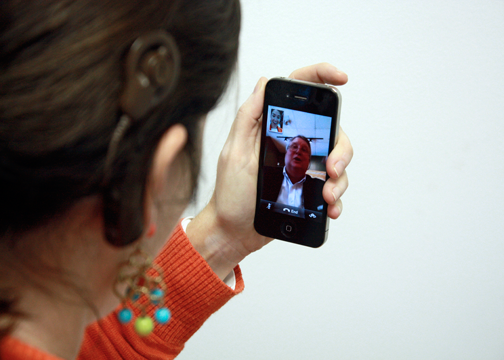AARP Hearing Center
Thursday Tech: Lip-Reading, A Thousand Miles Away
By Beth Carpenter, October 28, 2010 05:57 PM

(Image provided courtesy of Catharine McNally, who blogs about accessibility issues at Keen Guides.)
Catharine McNally is deaf. Or, at least, she was. Meningitis killed her hearing - but she's now able to hear some sounds with the aid of a cochlear implant. We asked her a little bit about the challenges she faces on a daily basis, and here's what she said:
Beth: Tell me a story about a gadget that suddenly made accessibility easier for you or someone you know.
Catharine: A few years ago, I walked into a museum with my family to see a neat exhibit. My family wanted to check out the audio tour, and being the one who is deaf, I asked for an accessible alternative. The alternative I got was a 50-page transcript. It was cumbersome and awkward for me to carry around.
A lightbulb came on in my head: I could take this transcript home, create a video version of it on my laptop camera with me narrating the tour, make it captioned, and put it on my iPod.
With this accessibility solution in the palm of my hands, I connected with two people I knew, to help me develop a pilot at a local art museum, and see if deaf and hard of people would enjoy these video tours as opposed to a transcript. As expected, these participants loved the opportunity to have an independent, engaging experience using everyday technology. What surprised us most was that people who did not consider themselves "deaf or hard of hearing," including baby boomers, came up to us and asked if they could use the iPod tours. That segment reported that seeing captioning on the iPod Touch screen was helpful to follow along with the narrator, especially with the presence of background noise in the museum.
Beth: Can you name a few recent devices that have changed the way you, or friends and loved ones with disabilities, live on a daily basis?
Catharine: 1 in 5 Americans have tried video-calling, or use it on a regular basis, according to the Pew Internet & American Life Project. This is done through Apple's FaceTime (for iPhone 4, Mac, and iTouch) and iChat, Google Talk, and Skype, all of which are free services. With networks becoming more robust and richer, we can expect to see this number increase as they become more widespread on our every day devices. It's great to be able to sit on the couch and visually talk with someone else, which is a great support for lip-reading. I wouldn't be surprised that in the years to come, we'll be able to have automatic, live captioning of the dialogue between the two callers.































































